Food detectives: decoding labels and navigating the supermarket
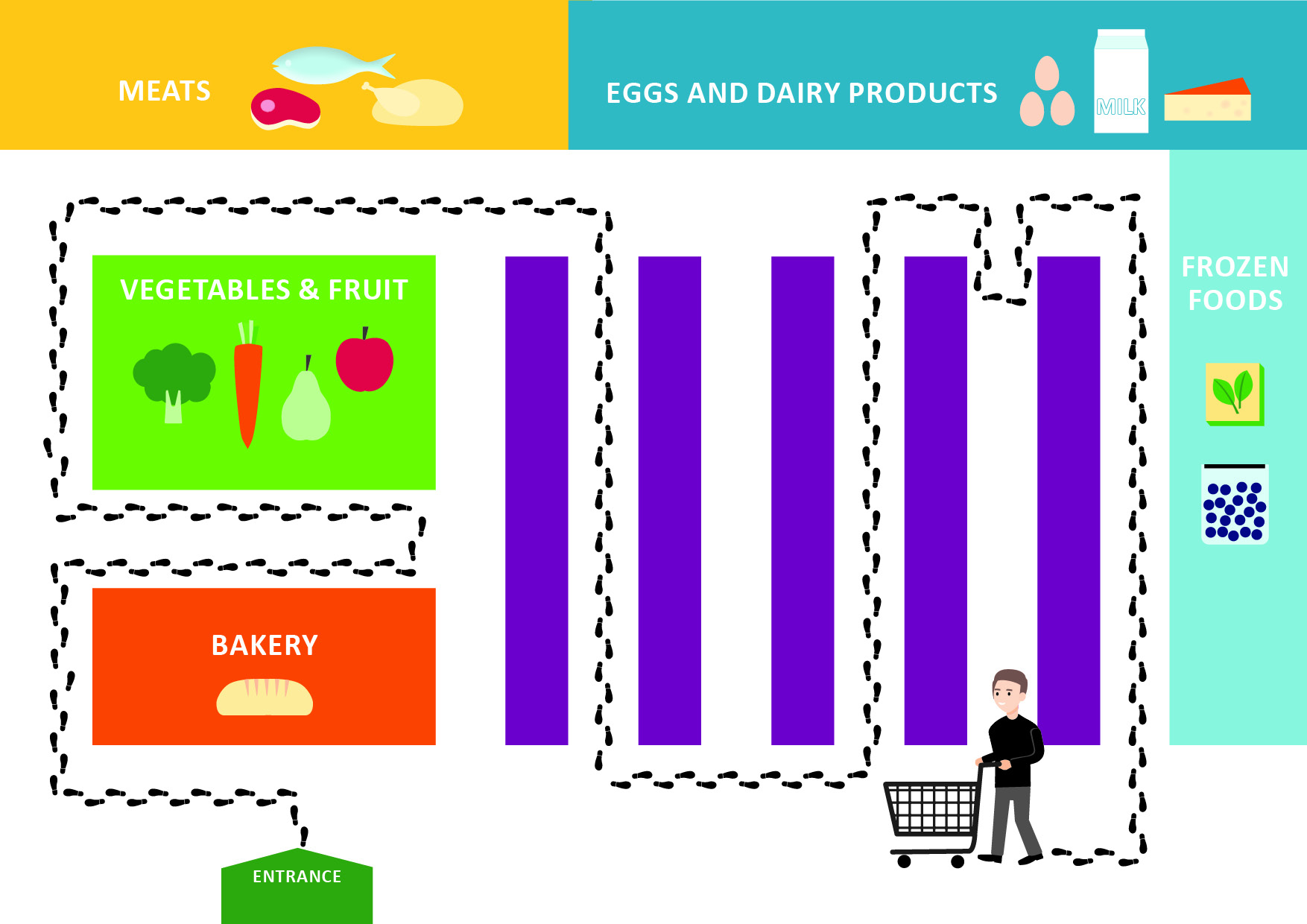
At every turn of the trolley, we’re faced with food advertising, health claims, discounts, and promotions. To help you confidently judge your options at the supermarket we’ve put together this guide to navigating the aisles.
Get wise to marketing tricks
The processed food industry spends a lot of money on product packaging and marketing each year to sell their products. Many of these tactics are purposefully misleading and confusing.
Nature calls
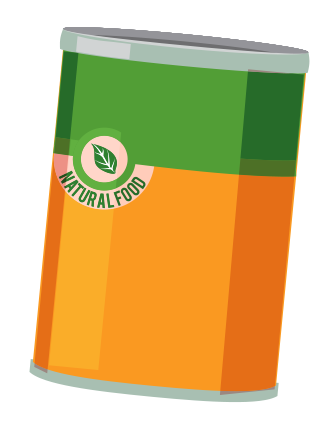 Use of earthy colours, paper or recycled packaging, and words such as ‘natural’ or ‘real' are all used to make products appear less processed and more healthy.
Use of earthy colours, paper or recycled packaging, and words such as ‘natural’ or ‘real' are all used to make products appear less processed and more healthy.
Big claims
Whilst all nutrition claims must be true (e.g. ‘98% fat free’ or ‘25% less salt’), these are sometimes placed on packaging as a distraction. A muesli bar that is 98% fat free may still be very high in added sugars or low in fibre. The best way to beat this is to look past the packaging and go straight to the nutrition label.
Pester power
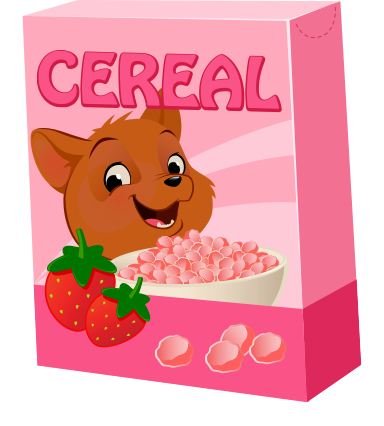 Cartoon characters and free toys are often used to advertise junk food to kids. Ever noticed where those cereal boxes are? They’re at kids’ eye-level. These foods are usually highly processed and full of sugar, fat, salt, and other cheap ingredients.
Cartoon characters and free toys are often used to advertise junk food to kids. Ever noticed where those cereal boxes are? They’re at kids’ eye-level. These foods are usually highly processed and full of sugar, fat, salt, and other cheap ingredients.
Decoding food labels

Ingredient list
A long ingredient list often means a food is highly processed. Whole foods and foods with only a few ingredients are usually cheaper and better for our health.
Ingredients are listed in order from the largest weight to the smallest weight. If sugar, fat, or salt (sodium) are listed within the first few ingredients, this can be a red flag!
Some food companies may use a few different types of sugars, fats, or salts in their products, making it harder to tell how much has been added. For example, a muesli bar may have brown sugar, malt, and honey listed in the ingredient list, all of which are added sugars. When broken down, all types of sugar and salt will be used in the body in a similar way. Check out our list of alternative names:
Reading the ingredients list? Here are some common names for sugar and salt. |
|||
| SUGAR | SALT | ||
| Agave nectar | Golden syrup | Celery salt | Sodium |
| Brown sugar | Honey | Flavour enhancer (msg) | Soy sauce |
| Corn Syrup | Invert sugar | Himalayan pink salt | Stock |
| Fructose | Malt | Meat extract | Table salt |
| Fruit juice concentrate | Maple syrup | Rock salt | Vegetable extract |
| Glucose | Rice Syrup | Sea salt | Yeast extract |
| Sucrose | |||
Nutrition panels
In Australia, packaged foods must display a nutrition information panel. The panel shows the amount of nutrients ‘per serving size’ and ‘per 100g’. Use the ‘per 100g’ column to compare products – the serving size is often different from one brand to another.
Here’s our guide to decide if a product is a healthy option. These numbers are not the only important thing but they’re a good place to start!
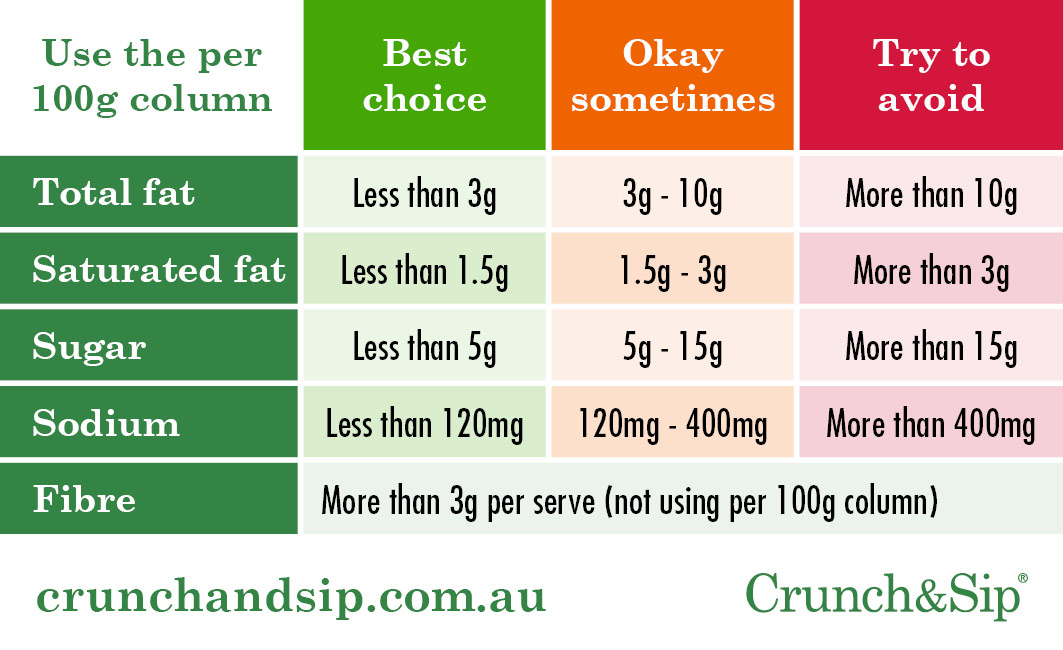
Hint: you can order a hard copy of this card to keep in your wallet, or take a picture on your phone to easily refer to it at the shops.
A shortcut!
Reading nutrition labels can be very time consuming, especially if you compare the sugar, fat, sodium, and fibre on every box! Get familiar with the nutrients of interest in different products. Here’s a quick guide of what to look for in some grocery staples.
The below table highlights the nutrients to focus on for each type of food.
|
Food |
Key nutrients of interest |
|||
|
Breakfast cereal |
Sugar |
Fat |
Sodium |
Fibre |
|
Breads |
Sugar |
Fat |
Sodium |
Fibre |
|
Crackers and rice cakes |
Sugar |
Fat |
Sodium |
Fibre |
|
Tinned vegetables |
Sugar |
Fat |
Sodium |
Fibre |
|
Tomato pasta sauce |
Sugar |
Fat |
Sodium |
Fibre |
|
Creamy pasta sauce |
Sugar |
Fat |
Sodium |
Fibre |
|
Other meal sauces |
Sugar |
Fat |
Sodium |
Fibre |
|
Condiments |
Sugar |
Fat |
Sodium |
Fibre |
Skip the label reading…
Many people find food labels hard to understand. Rest assured it’s because they’re often designed to be confusing! The easiest way to avoid having to read labels is to choose foods that don’t have them. Fresh produce such as vegetables, fruits, fresh meat, fish, and eggs are not required to have labels because they are whole foods. This means they have gone through minimal processing and contain few additives. If you are choosing whole foods such as these you can be confident your choice provides plenty of essential vitamins and minerals and no cheap fillers.
Plan your route
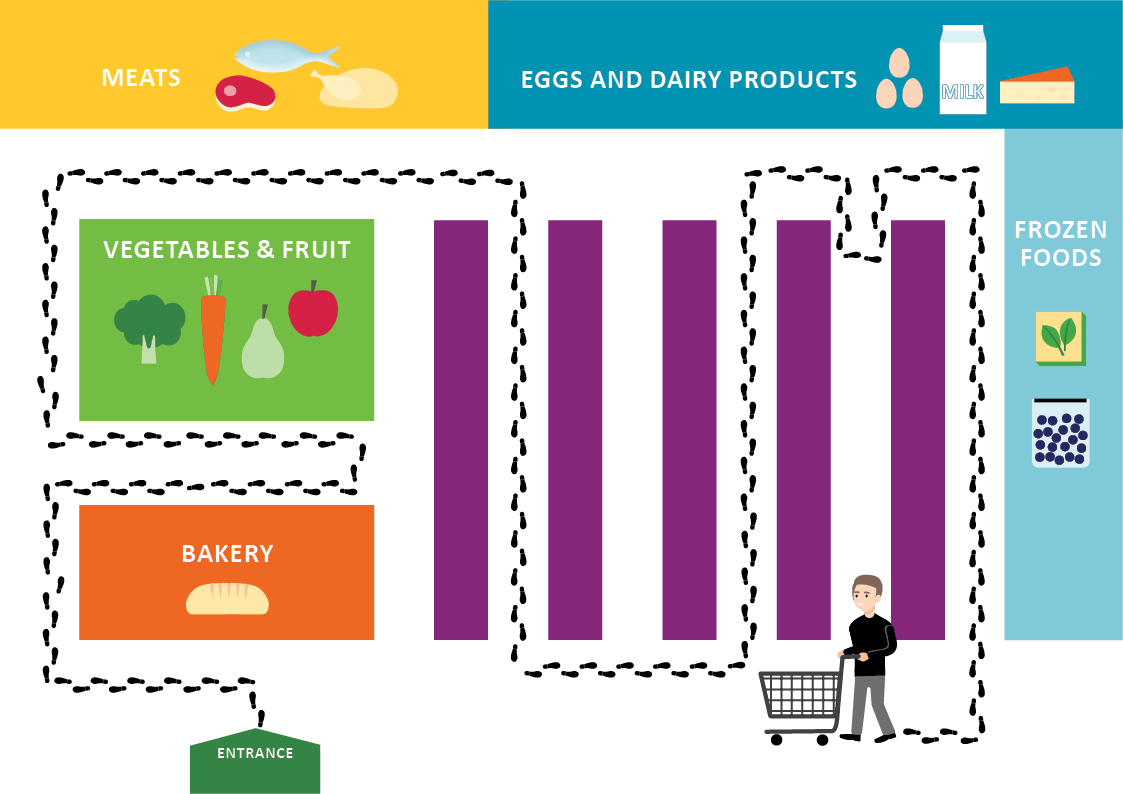 Whole foods are mostly found around the perimeter or outside aisles of the supermarket because they are fresh, have a high turnover and are often in need of refrigeration. You’ll probably still need to duck into the inside aisles for some essentials. This is where you’ll see the highly processed foods which usually come with higher amounts of sugar, fat and salt. And a whole lot more bright packaging and marketing. Write a shopping list and go on targeted missions rather than browsing down every aisle. As an added bonus, you can also skip certain aisles completely (I’m looking at you chips, lollies and sugary drinks) and avoid pester power from junior shopping assistants.
Whole foods are mostly found around the perimeter or outside aisles of the supermarket because they are fresh, have a high turnover and are often in need of refrigeration. You’ll probably still need to duck into the inside aisles for some essentials. This is where you’ll see the highly processed foods which usually come with higher amounts of sugar, fat and salt. And a whole lot more bright packaging and marketing. Write a shopping list and go on targeted missions rather than browsing down every aisle. As an added bonus, you can also skip certain aisles completely (I’m looking at you chips, lollies and sugary drinks) and avoid pester power from junior shopping assistants.
Navigating the supermarket is tough, and the odds are often against us. We hope you can bring in some of these tips to your next supermarket adventure. But take it from old pros; just pick a few foods to do a deep dive into each shopping trip. You’ll be there forever if you overhaul your whole grocery list in one trip!